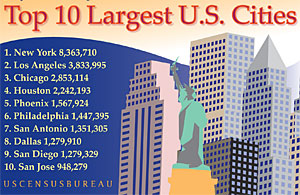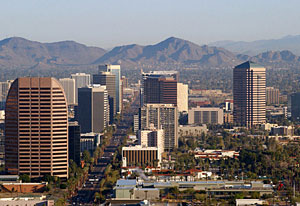Fueled by programs begun in the Great Depression, sprawl has been the dominant mode of residential development in the U.S. for decades. But the current recession and credit freeze, coupled with high-energy prices, have prompted a reassessment. “We're seeing a pretty remarkable historical moment,” says Dolores Hayden, professor of architecture and urbanism at Yale University. "When the economy is declining, it's a tremendous opportunity to rethink this system.”


Photo courtesy Wikipedia (above).
In Phoenix (pictured above), attention has shifted to the urban core, in part because of the city's new light rail.
In late June, Harvard's Joint Center for Housing Studies released its annual State of the Nation's Housing Report, which found that foreclosure rates are skyrocketing and housing demand is weak. While many urban neighborhoods are reeling, the suburbs are faring worse in some areas. In the Chicago area, for example, the Cook County suburbs saw almost twice the rate of new foreclosure filings as the city proper in the first quarter of 2009, says the Woodstock Institute, a community reinvestment and economic development nonprofit.
For years, researchers have predicted that people increasingly will migrate to cities. But the economic crisis could accelerate this trend. “There's a lot of evidence that sprawl is on the wane," says Kermit Baker, AIA chief economist and senior research fellow at the Harvard Joint Center. “The question is whether this is a cyclical or secular; [non-periodic] trend.”
John Norquist, president of The Congress for the New Urbanism, which held its annual conference in Denver last month, says it’s a long-term shift. “I think it will be a return to business as usual, as defined over thousands of years—compact development, diverse uses, close proximity of jobs and houses," he says of future planning strategies. “Market forces are kind of putting it back together."
Once the credit markets thaw and the economy bounces back, demographics will favor re-centralization, adds Laurie Volk, co-managing director of Zimmerman/Volk Associates, a residential real estate research firm. Along with the shrinking of average household size, the Baby Boom generation is moving in greater percentages than previous generations to urban centers and edge neighborhoods, and the succeeding "echo boom" generation is also drawn to cities. "Development has come to a screeching halt everywhere,” she says, “but if there's any activity it's usually downtown and not at the exurban edge." Cash-strapped municipalities are also less likely to encourage building that requires new infrastructure, she adds.
In Phoenix, attention has shifted to the urban core, in part because of the city's new light rail. Visions of an expanded system, and high-speed intercity rail links with Tucson and Flagstaff, have boosted enthusiasm for infill and transit-oriented development. "The recession is forcing us to reexamine our central core and look at adding affordable housing," says Mark Patterson, AIA, a vice president at Smith Group and president of AIA Arizona. "The recovery could refuel the move to the periphery, where first-time buyers can find more affordable housing. But I get the sense, especially if gas goes higher, the legacy that we realize from this current situation is that sprawl will be minimized."
But even with a heightened interest in mass transit and electric cars, centralization won't come easily to the region, according to Christiana Moss, AIA, principal at Studio Ma, a Phoenix firm whose portfolio includes infill projects. She says of the development attitude in the West: “The ethos is get on your horse and move on.”



